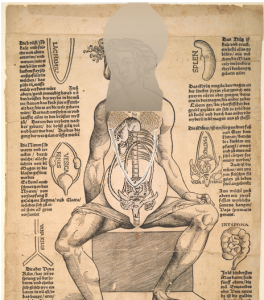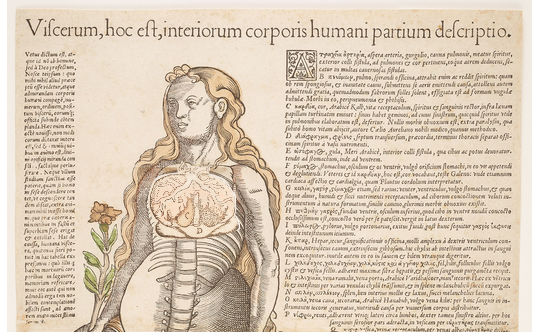As Curator for the History of Medicine Collections in the Rubenstein Rare Book & Manuscript Library, I have the opportunity to work with incredible items, including Renaissance era amputation saws, physician case books from the nineteenth century, and anatomical illustrations with moveable parts, just to name a few.


In my opinion, our holdings of anatomical fugitive sheets are some of the most remarkable and rare items one can find in historical medical collections. Our collection includes ten of these sheets, and each one is fascinating for its own reasons.
These anatomical fugitive sheets, which date from the early sixteenth to the mid-seventeenth centuries, are single sheets, similar to broadsides, that are unique in that they contain overlays or flaps that lift to reveal the inside of the human body.
I have read arguments that such items would have been used by barber surgeons or medical students, but others say these were hung in apothecary shops or purchased and kept by individuals with an interest in knowing what was inside their body. After almost 500 years, it is amazing that these anatomical fugitive sheets still exist. While we do have a few sheets that have lost some or all of their flaps, I think it’s fascinating to examine where flaps are broken. Somehow these broken and missing parts make these sheets more real to me – a reminder that each one has a story to tell. How and when did the flap get torn? How would this have really been used in 1539?
After the success of our Animated Anatomies exhibit, many of my colleagues and I have been discussing how to make our materials that contain flaps available online. I can tell you, it’s no easy task, but I am thrilled that we now have a digital version of our collection of anatomical fugitive sheets. With funding from the Elon Clark Endowment, a local custom web design firm, Cuberis, was outsourced to create the code, making these items interactive. Our own amazing Digital Collections Team not only photographed each overlay, but also took the code and applied it to DUL’s digital collection site, making it all work freely to a public audience.
There are so many people involved in making something like this happen. Thanks to Mark Olson, Cordelia and William Laverack Family Assistant Professor of Art, Art History & Visual Studies here at Duke University, for his role in getting this project started. And here in the DUL – a huge thanks to Erin Hammeke (Conservation), Mike Adamo and Molly Bragg (Digital Production Center), Noah Huffman and Lauren Reno (Rubenstein Library Technical Services), Will Sexton, Cory Lown, and especially Sean Aery (Digital Projects Department). They are an incredible team that makes beautiful things happen. Obviously.
Post contributed by Rachel Ingold



2 thoughts on “The History of Medicine’s Anatomical Fugitive Sheet Digital Collection”
Comments are closed.